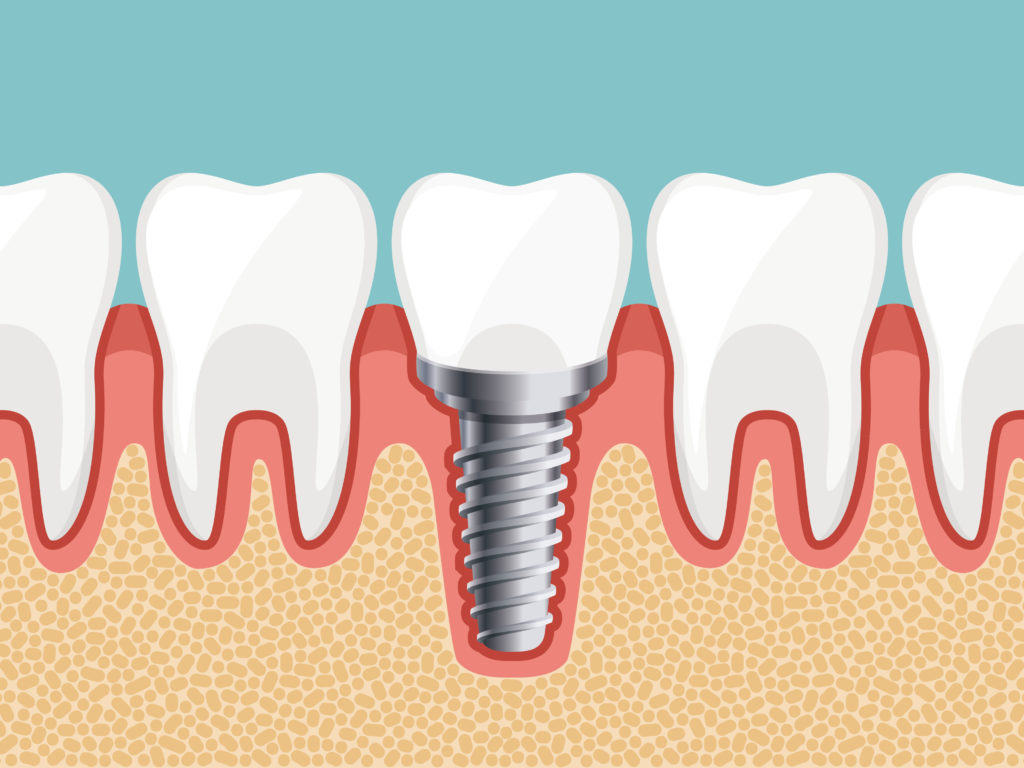Implantology
by Dr. Sofia Bettini
Implantology is the branch of dentistry that deals with the replacement of missing teeth through implants, which are “screws” anchored in the bone to support new teeth.
This technique has been developed since the 1970s and is based on the process of osseointegration, i.e. fusion between the implant and the bone. The implant is usually made of a titanium alloy, which is a biocompatible material widely used in medicine. From the 70s to today, many advances have been made regarding the materials and techniques used, to improve the final result.
The main advantage of implants is that, by acting as “synthetic roots”, they allow you to replace lost teeth without the need to anchor to neighboring teeth.
If a single tooth is missing, for example, an implant-supported crown can be placed, rather than bridging the two adjacent teeth. It is also possible to use implants as abutments to make a bridge of several artificial teeth, supported by implants.
If all teeth are missing, implants can be used either to stabilize a removable prosthesis or as an anchor for a fixed full denture.
The standard protocol of rehabilitation through implants includes:
- Tooth extraction
- Waiting for at least 2-3 months of gum and bone healing
- Implant Placement
- Waiting for at least 3 months of osseointegration of the implant to the bone
- Impressions and placement of the prosthesis
The surgical implant placement procedure is performed under local anesthesia, may involve antibiotic coverage, and requires 1-2 weeks of rest after surgery. In the first post-operative days it is possible to have some swelling and pain, which can be controlled with standard anti-inflammatories.
In some cases, it is possible to avoid waiting for the healing phase of the gum and bone by placing immediate post-extraction implants. This technique, which is more complex than the traditional one, allows the patient to reduce the time required for rehabilitation.
Sometimes, in addition to the implant, it is also possible to place the implant-supported prosthesis right away, making an immediate loading. This approach allows the patient to remain toothless for as little time as possible. However, it is always important to respect the osseointegration phase; Therefore, for the first 3 months the prosthesis will only have an aesthetic function, because the implants cannot be subject to trauma or loading.
After the loss of a tooth, the bone and gum tend to resorb over time, especially if the tooth had caused one or more infections or abscesses.
If the bone resorbs a lot, it may need to be reconstructed to make it possible to place an implant of the correct diameter or length. Bone regeneration is performed with a mixture of bone taken from the patient (usually near the area where the tooth is missing) and synthetic bone, stabilized with a membrane, forming a plaster-like structure. Sometimes it is possible to regenerate bone during implant placement. When a lot of bone is missing, it is necessary to wait 6-8 months after bone regeneration, before implants can be placed.
If the gum resorbs a lot, it may be necessary to build it up in order to protect the implant from bacterial infiltration and inflammation. The most commonly used technique involves taking a graft from the patient’s palate, which is sutured to the gum around the implant. This procedure can be performed both during implant placement and around implants that are already placed.
Prosthetics on implants are very similar to those on natural teeth. Depending on the needs, temporary or permanent prostheses can be placed, made of composite, ceramic or zirconia. The crowns can be screwed onto the implant or cemented.

No cavities can form on implants, but it is important to avoid plaque and tartar buildup, which can cause inflammation of the gum and resorption of bone around the implant. Therefore, it is important that the patient performs correct oral hygiene maneuvers at home with a toothbrush and interdental brush. In addition, the patient is placed in a control and maintenance program with the dentist and dental hygienist.
Mucositis is inflammation of the gum around the implant, causing redness, bleeding, swelling, slight discomfort, or pain when brushing. To resolve mucositis, a thorough cleaning of the gum around the implant is necessary, performed by the dentist or dental hygienist, associated with a therapy with disinfectant gels and mouthwashes.
If left untreated, inflammation can cause bone resorption around the implant and become peri-implantitis: in addition to bleeding and swelling, there may be halitosis and exposure of part of the implant in the oral cavity. In the case of peri-implantitis, it may be necessary to perform an implantoplasty: this technique involves surgical access to the implant, which is cleaned and polished to reduce tartar accumulation. The surgical procedure is performed under local anesthesia, may involve antibiotic coverage, and requires 1 week of rest after surgery. In the first post-operative days it is possible to have some swelling and pain, which can be controlled with standard anti-inflammatories.

